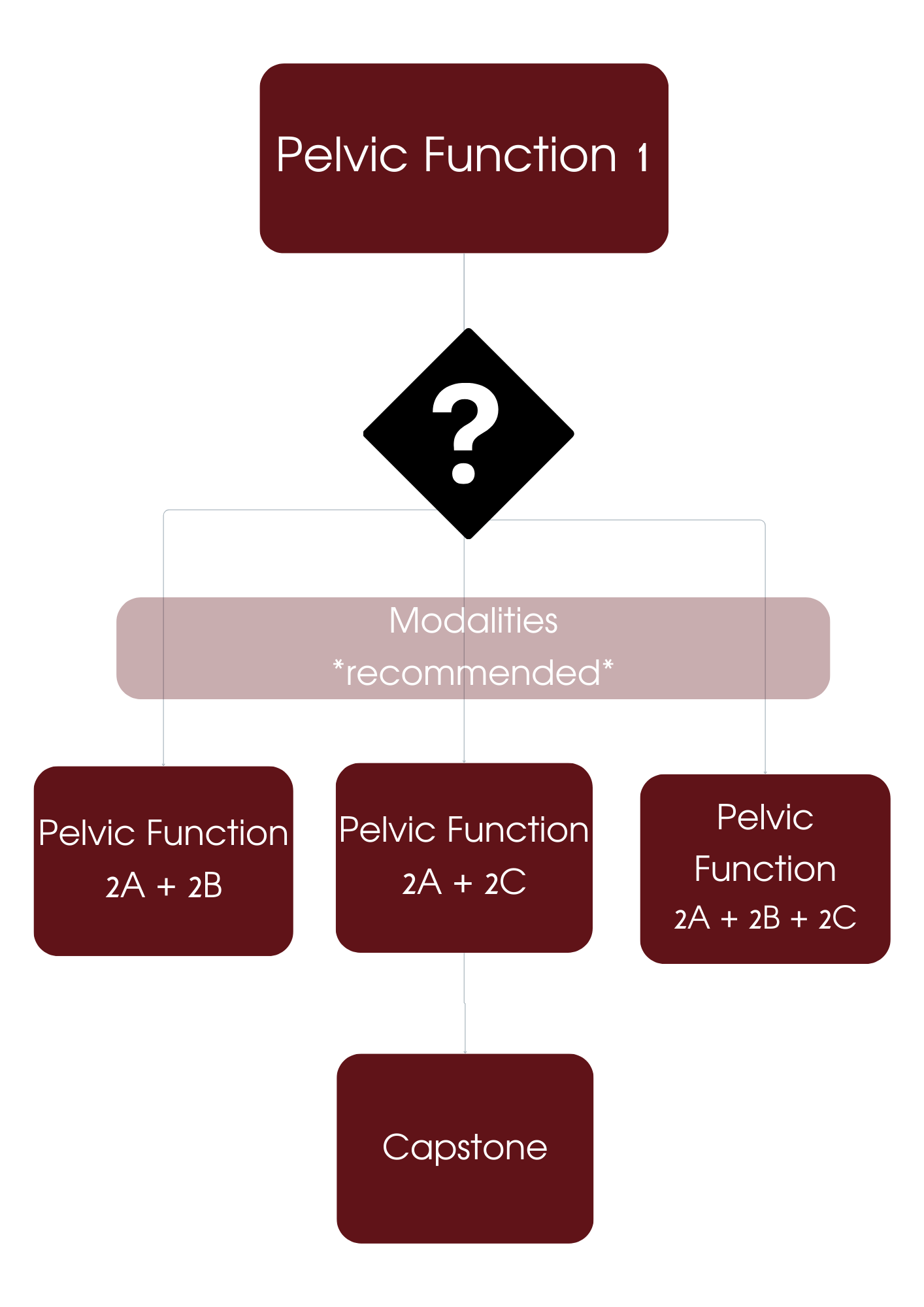Which Courses Do I Take to Become a Pelvic Rehab Therapist?
Which Courses Do I Take to Become a Pelvic Rehab Therapist?

Step 1: Pelvic Function Level 1
If you are licensed as a PT, PTA, OT, nurse, ND, or other practitioner, you can start learning to specialize in pelvic rehabilitation. (You can view a list of Who Can Take a HW Course here).
HW courses are classified as Beginner (no prerequisites), Intermediate (one prerequisite) and Advanced (two or more prerequisite courses). Any Beginner-level course would be appropriate to take as a first-time course.
If you are looking for the Beginner-level course to start your journey in pelvic rehab, the best place to start is with our Pelvic Function Level 1 - Introduction to Pelvic Health. PF1 will provide a thorough and comprehensive introduction to anatomy and physiology of the pelvis and surrounding structures in all genders. This course includes an introduction to performing intra-vaginal exam, and is offered in satellite and in-person formats so that HW faculty and teaching assistants can guide you through your first internal exam.
Step 2: Start Seeing Patients and Choose your Next Course
Once you have completed PF1, you will have knowledge and skills to see your first pelvic patients. Practice what you have learned in the clinic, and choose your Intermediate-level course based on what patients show up.
The next coures in the Pelvic Function Series are:
Modalities and Pelvic Function: Pelvic Health Clinical Toolkit
Pelvic Function Level 2A: Colorectal Pelvic Health and Pudendal Neuralgia, Coccyx Pain
Pelvic Function Level 2B: Urogynecologic Topics in Pelvic Health
Pelvic Function Level 2C : the Male Pelvic Floor and Men’s Pelvic Health
You may see patients with fecal incontinence or coccyx pain and may choose to prioritize Level 2A (which focuses on colorectal topics) as the next step in their journey. Others may see patients with penile pain or incontinence post-prostatectomy and may choose to take Level 2C (which focuses on men's health) as their next step. You may also wish to take the Modalities course in order to learn evidence-based use of modalities and practice biofeedback and Estim in a hands-on, in-person setting. The best way to choose which course to take next will be determined by who shows up in your clinic after completing PF1 and beginning to see your first pelvic patient caseload.
Step 3: Think Outside the Series
The Pelvic Function Series is designed to be foundational and comprehensive. Each level covers a broad swath of patient presentations and evaluation and treatment approaches. As a pelvic rehab therapist, you may find that patients come into the clinic with specialized needs. HW offers a lot of specialty courses to address topics in pelvic rehab, including our series on Oncology, Perinatal Topics, and Pediatrics.
Specialty courses also cover specific modalities like Rehabilitative UltraSound and Dry Needling, or manual therapy techniques like Fascial Mobilization.
Herman & Wallace is always updating existing courses and developing new content. Be sure to check out our full pelvic floor therapy continuing education course catalog. Again, the next course you take should be based on who is showing up in the clinic.
Step 4: Complete the Series and other Advanced Courses
The Capstone course is the advanced course in our Pelvic Function series. This final course in the series is intended for the therapist who is experienced in treating the pelvic floor patient, has a strong understanding of pelvic anatomy including muscles and nerves, and strong pelvic floor palpation skills. Lab work instructed will cover manual therapy treatments addressing fascia and nerves.
As we understand the “advanced pelvic floor clinician” may have a variance of experience and focuses, the following course “journeys” can all be taken in order to take the Capstone course:
PF1
PF2A
P2B and/or PF2C
The Modalities course is strongly recommended, but not required, in order to take the Capstone course.
Most therapists continue to take additional specialty coursework leading up to and after taking Capstone. The learning journey of a pelvic rehab therapist never ends!
Step 5: Become a Certified Pelvic Floor Therapist
Once you have years of clinical experience under your belt, you may be eligible to sit for the Pelvic Rehabilitation Practitioner Certification (PRPC). The Pelvic Rehab Practitioner Certification (PRPC) was introduced in 2013 out of a desire to offer a distinguishing credential for those treating pelvic health in all genders throughout the life cycle.
Those who sit for and successfully pass the multiple choice exam earn the letters PRPC to put after their name to demonstrate this clinical competency.
There are no required courses in order to sit for the PRPC exam. Rather, our courses instruct in the skills and knowledge one will use in the clinic, ultimately building the practical clinical experience that will be covered on the exam.To be eligible to sit for the exam, all applicants must have completed 2000 licensed hours of direct pelvic patient care in the past 8 years, 500 of which must have been completed in the last 2 years. For more info about eligibility, please see our Pelvic Rehabilitation Practitioner Certification page.
